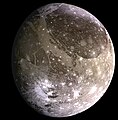Файл:The Galilean satellites (the four largest moons of Jupiter).tif

Розмір цього попереднього перегляду JPG для вихідного TIF-файлу: 800 × 262 пікселів. Інші роздільності: 320 × 105 пікселів | 640 × 210 пікселів.
Повна роздільність (1830 × 600 пікселів, розмір файлу: 1,51 МБ, MIME-тип: image/tiff)
Історія файлу
Клацніть на дату/час, щоб переглянути, як тоді виглядав файл.
| Дата/час | Мініатюра | Розмір об'єкта | Користувач | Коментар | |
|---|---|---|---|---|---|
| поточний | 12:54, 29 грудня 2011 | 1830 × 600 (1,51 МБ) | Prof. Professorson | {{Information |Description=This composite includes the four largest moons of en:Jupiter which are known as the Galilean satellites. The Galilean satellites were first seen by the Italian astronomer en:Galileo Galilei in |
Використання файлу
Такі сторінки використовують цей файл:
Глобальне використання файлу
Цей файл використовують такі інші вікі:
- Використання в af.wikipedia.org
- Використання в als.wikipedia.org
- Використання в ar.wikipedia.org
- Використання в ast.wikipedia.org
- Використання в az.wikipedia.org
- Використання в ba.wikibooks.org
- Використання в be-tarask.wikipedia.org
- Використання в be.wikipedia.org
- Використання в bg.wikipedia.org
- Використання в bn.wikipedia.org
- Використання в bn.wikibooks.org
- Використання в bs.wikibooks.org
- Використання в ca.wikipedia.org
- Використання в cs.wikipedia.org
- Використання в en.wikipedia.org
- Використання в en.wikibooks.org
- Використання в es.wikipedia.org
- Використання в et.wikipedia.org
- Використання в eu.wikipedia.org
- Використання в fi.wikipedia.org
- Використання в fr.wikipedia.org
- Використання в gl.wikipedia.org
- Використання в he.wikipedia.org
- Використання в hi.wikipedia.org
- Використання в hu.wikipedia.org
- Використання в hy.wikipedia.org
- Використання в id.wikipedia.org
- Використання в it.wikipedia.org
- Використання в ja.wikipedia.org
- Використання в kk.wikipedia.org
- Використання в ko.wikipedia.org
Переглянути сторінку глобального використання цього файлу.




